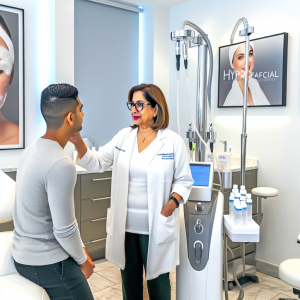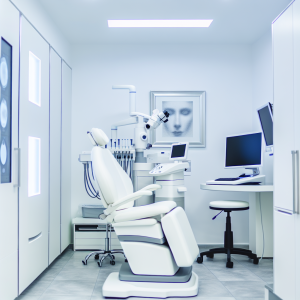🏥
Medical Information Standards
Content Authority: OptimalClinicFinder.com is a comprehensive medical directory platform connecting patients with qualified Botox providers. Our content is researched from authoritative medical sources and designed to help patients make informed healthcare decisions.
How Botox Works: Clinical Mechanism and Applications
Botox (onabotulinumtoxinA) belongs to a class of neurotoxins that work by blocking nerve signals to targeted facial muscles. When injected around the eyes, the medication binds to nerve terminals and prevents the release of acetylcholine, a neurotransmitter responsible for muscle contraction. This temporary paralysis of hyperactive facial muscles reduces the formation of dynamic wrinkles, including crow’s feet, laugh lines, and expression lines.
The medication’s precision targeting allows skilled practitioners to selectively weaken specific muscle groups while preserving natural facial expression. The periorbital area requires particular expertise due to the complex interplay between the orbicularis oculi, procerus, and corrugator muscles. This multi-target approach addresses the intricate muscular dynamics that contribute to aging around the eyes, making it particularly effective for patients seeking natural-looking results without complete muscle immobilization.
💡
Did You Know?
Clinical studies show that Botox patients achieve excellent results when combined with professional-grade aftercare products.
Clinical Research and Evidence Base
The clinical development of periorbital Botox involved multiple large-scale randomized controlled trials, including the landmark CROW and FACE studies. These trials enrolled over 1,500 participants across diverse demographics and followed patients for up to 12 months. The primary endpoint data consistently demonstrated significant improvements in crow’s feet severity, patient satisfaction scores, and investigator global assessments compared to placebo injections.
Subgroup analyses revealed that Botox effectiveness extends across different age groups, skin types, and wrinkle severities. The medication showed particular efficacy in patients aged 30-65 with moderate to severe periorbital rhytides. Long-term extension studies have confirmed durability of benefits lasting 3-4 months per treatment cycle, with many patients maintaining satisfaction for extended periods through regular maintenance treatments.
Treatment Protocols and Clinical Management
Successful periorbital Botox treatment requires careful patient selection and individualized injection planning. The initial evaluation process includes comprehensive facial analysis, muscle movement assessment, skin quality evaluation, and discussion of realistic expectations. Healthcare providers must assess facial symmetry, identify dominant muscle groups, and develop customized injection patterns.
The standard treatment protocol involves strategic placement of 12-20 units of Botox distributed across 3-5 injection points per eye area. Most patients receive bilateral treatment with 6-12 units for crow’s feet, 10-25 units for glabellar lines, and 6-15 units for forehead wrinkles when treating the complete upper face. Injection technique includes using 30-32 gauge needles, maintaining 1cm distance from the orbital rim, and avoiding the levator palpebrae muscle to prevent ptosis complications.
💡
Quick Tip
Botox works best when combined with healthy lifestyle choices for optimal results.
Safety Profile and Risk Management
The safety profile of periorbital Botox has been extensively characterized through clinical trials and over 20 years of post-marketing surveillance. The most common adverse events include temporary injection site reactions, mild bruising, and headache, which typically occur within 24-48 hours and resolve within one week. Healthcare providers can minimize these effects through proper injection technique, ice application, and pre-treatment preparation.
Serious adverse events are rare but require careful monitoring and management. These include eyelid ptosis (0.5-2% incidence), eyebrow ptosis, diplopia, and asymmetrical results. Risk factors for complications include inexperienced injectors, excessive dosing, improper injection placement, and failure to respect facial anatomy. Contraindications include pregnancy, breastfeeding, neuromuscular disorders, and allergy to botulinum toxin or albumin.
Cost Analysis and Access Considerations
The cost of Botox around eyes treatment varies significantly based on geographic location, provider expertise, and treatment scope. Without insurance coverage, the average treatment cost ranges from $300 to $800 per session, depending on units required and regional pricing. Most patients require 20-40 total units for comprehensive periorbital treatment, with pricing typically calculated per unit ($10-20) or per treatment area ($200-400).
⚠️
Safety First
Always consult a qualified medical professional before starting Botox. Results vary by individual.
Insurance coverage for cosmetic Botox is generally not available, as treatments are considered elective aesthetic procedures. However, some patients may qualify for coverage when Botox is used for medical conditions like chronic migraines or excessive sweating. Payment options include cash pricing, financing plans through companies like CareCredit, and package deals for multiple treatment areas or maintenance schedules.
Botox Around Eyes Results and Maintenance
Patients typically begin seeing initial results from botox around eyes treatments within 3-5 days, with optimal results developing over 10-14 days as the neurotoxin takes full effect. The improvement in crow’s feet and periorbital wrinkles continues to enhance for up to 2 weeks post-treatment. Most patients achieve 80-90% reduction in dynamic wrinkles, with some static lines also showing improvement due to reduced repetitive muscle movement.
✓
Why Choose Botox?
●
Clinically proven
●
FDA approved
●
Minimal downtime
●
Long-lasting
Results from botox around eyes treatments typically last 3-4 months, though individual variation exists based on metabolism, muscle strength, lifestyle factors, and treatment history. Regular maintenance treatments every 3-4 months help sustain optimal results, with some patients finding they can extend intervals to 4-6 months after multiple treatment cycles. Combining Botox with complementary treatments like dermal fillers, laser therapy, or medical-grade skincare can enhance and prolong aesthetic outcomes.
Provider Selection and Treatment Access
Choosing an experienced healthcare provider is crucial for optimal botox around eyes treatment outcomes. Patients should seek board-certified dermatologists, plastic surgeons, or experienced injectors with specific expertise in facial anatomy and aesthetic medicine. Important qualifications include proper medical training, ongoing education in injection techniques, understanding of facial proportions, and experience managing complications.
Access to qualified Botox providers has expanded significantly as aesthetic medicine has grown. Many medical spas, dermatology practices, and plastic surgery centers now offer periorbital treatments. However, patients should prioritize provider credentials over convenience or price, as improper injection technique can result in unsatisfactory results or complications requiring corrective treatment.
📚 Medical Authorities & Professional Standards
All Botox procedures should be performed by licensed medical professionals following established clinical guidelines and safety protocols.
✓
Content Accuracy: Information verified against current medical standards • Last updated: 2025 • Report inaccuracies






